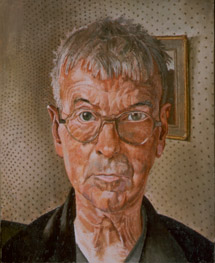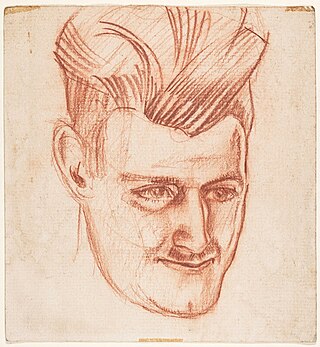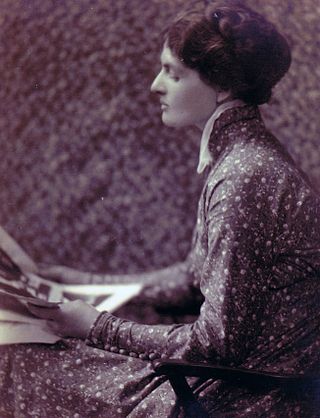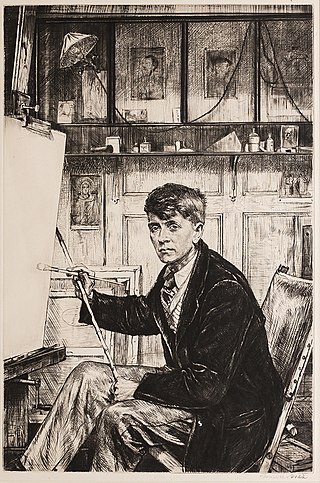
The Imperial War Museum (IWM), currently branded "Imperial War Museums", is a British national museum. It is headquartered in London, with five branches in England. Founded as the Imperial War Museum in 1917, it was intended to record the civil and military war effort and sacrifice of the United Kingdom and its Empire during the First World War. The museum's remit has since expanded to include all conflicts in which British or Commonwealth forces have been involved since 1914. As of 2012, the museum aims "to provide for, and to encourage, the study and understanding of the history of modern war and 'wartime experience'."

Sir Stanley Spencer, CBE RA was an English painter. Shortly after leaving the Slade School of Art, Spencer became well known for his paintings depicting Biblical scenes occurring as if in Cookham, the small village beside the River Thames where he was born and spent much of his life. Spencer referred to Cookham as "a village in Heaven" and in his biblical scenes, fellow-villagers are shown as their Gospel counterparts. Spencer was skilled at organising multi-figure compositions such as in his large paintings for the Sandham Memorial Chapel and the Shipbuilding on the Clyde series, the former being a First World War memorial while the latter was a commission for the War Artists' Advisory Committee during the Second World War.

Christopher Richard Wynne Nevinson was an English figure and landscape painter, etcher and lithographer, who was one of the most famous war artists of World War I. He is often referred to by his initials C. R. W. Nevinson, and was also known as Richard.

A war artist is an artist either commissioned by a government or publication, or self-motivated, to document first-hand experience of war in any form of illustrative or depictive record. War artists explore the visual and sensory dimensions of war, often absent in written histories or other accounts of warfare.

Paul Nash was a British surrealist painter and war artist, as well as a photographer, writer and designer of applied art. Nash was among the most important landscape artists of the first half of the twentieth century. He played a key role in the development of Modernism in English art.
John Northcote Nash was a British painter of landscapes and still-lives, and a wood engraver and illustrator, particularly of botanic works. He was the younger brother of the artist Paul Nash.

Sir Muirhead Bone was a Scottish etcher and watercolourist who became known for his depiction of industrial and architectural subjects and his work as a war artist in both the First and Second World Wars.
Carel Victor Morlais Weight, was an English painter.
Sir Walter Thomas Monnington PRA was an English painter, notable for several large murals, his work as a war artist and for his presidency of the Royal Academy.

Alan Ernest Sorrell was an English artist and writer best remembered for his archaeological illustrations, particularly his detailed reconstructions of Roman Britain. He was a Senior Assistant Instructor of Drawing at The Royal College of Art, between 1931–39 and 1946–48. In 1937 he was elected a member of the Royal Watercolour Society.

Eric Henri Kennington was an English sculptor, artist and illustrator, and an official war artist in both of the world wars.

Ethel Léontine Gabain, later Ethel Copley, was a French-Scottish artist. Gabain was a renowned painter and lithographer and among the founding members of the Senefelder Club. While she was known for her oil portraits of actresses, Gabain was one of the few artists of her time able to live on the sale of her lithographs. She also did etchings, dry-points, as well as some posters.
Roland Vivian Pitchforth RA ARWS was an English painter, teacher and an official British war artist during the Second World War. He excelled at watercolours and in later years concentrated on landscapes, seascapes and paintings of atmospheric effects.
The War Artists' Advisory Committee (WAAC), was a British government agency established within the Ministry of Information at the outbreak of the Second World War in 1939 and headed by Sir Kenneth Clark. Its aim was to compile a comprehensive artistic record of Britain throughout the war. This was achieved both by appointing official war artists, on full-time or temporary contracts and by acquiring artworks from other artists. When the committee was dissolved in December 1945 its collection consisted of 5,570 works of art produced by over four hundred artists. This collection was then distributed to museums and institutions in Britain and around the world, with over half of the collection, some 3,000 works, going to the Imperial War Museum.

Charles Ernest Cundall,, , was an English painter of topographical subjects and townscapes, best known for his large panoramic canvases.
Dennis William Dring was a British portraitist.

Sydney William Carline was a British artist and teacher known for his depictions of aerial combat painted during World War One.
Mona Mary Moore, also known as Mona Bentin and later as Deborah Bentin, was a British painter and illustrator, best known for her work during World War Two for both the Recording Britain project and for the War Artists' Advisory Committee. Her work also appeared regularly in a number of magazines including Good Housekeeping, the Radio Times and The Listener.
The British War Memorials Committee was a British Government body that throughout 1918 was responsible for the commissioning of artworks to create a memorial to the First World War. The Committee was formed in February 1918 when the Department of Information, which had been responsible for war-time propaganda and also operated a war artists scheme, became the Ministry of Information with Lord Beaverbrook as its Minister. Beaverbrook had been running, from London, the Canadian Government's scheme to commission contemporary art during the First World War and believed Britain would benefit from a similar project. Beaverbrook wanted the British War Memorials Committee to change the direction of Government-sponsored art away from propaganda of short-term value only during the conflict to a collection with a much longer lasting national value. Arnold Bennett, alongside Beaverbrook, was the driving force behind the BWMC and was instrumental in ensuring young artists, including those seen as modernist or avant-garde, were commissioned by the Committee over older British artists, many of whom were associated with the Royal Academy.
Dorothy Josephine Coke was an English artist notable for her work as a war artist on the British home front during the Second World War. Coke was also an art teacher and as an artist was known for her watercolours, which have a very free, open-air quality to them.












